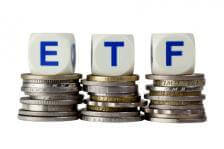Gold and Silver ETFs
Find out how these ETFs are taxed inside and outside of an IRA.
Elizabeth Carlassare
Listen
Gold and Silver ETFs
Today’s topic is making a golden nest egg.
Phil in Lakewood, Colorado e-mailed me with this question:
I was listening to your archives and in Episode 46, you mentioned that gains on gold ETF shares held for more than a year would be taxed at the higher collectibles rate of 28% rather than the long-term capital gains rate of 15%. What would happen if I sold all my gold ETF shares in my traditional IRA after holding for 11 months, used the proceeds to buy another stock, then sold that and rotated back into ETFs? Would I be taxed at a lower rate?
Great question! The answer to this question isn’t as straightforward as you might think at first. In fact, finding an answer to this question was a bit of a wild goose chase!
 Gold and Silver ETFs Are Taxed as Collectibles
Gold and Silver ETFs Are Taxed as Collectibles
The IRS considers owning physical gold or silver, including shares of exchange-traded funds (ETFs) that hold gold or silver for you, to be the same as owning a collectible. And you’re right, Phil: the long-term capital gains rate on collectibles is 28%, not the 15% that applies to stocks and other investments, which is really unfortunate. The short-term capital gains rate for gold or silver ETF shares is the same as for other investments: your ordinary income tax rate. These tax rates apply for shares held outside of a tax-advantaged account.
But what’s the scoop when it comes to owning gold or silver ETF shares inside an IRA?
Collectibles Are Not Allowed in an IRA
Although you can own almost any type of asset in an IRA, the IRS prohibits owning collectibles in an IRA, including metals and coins, except for certain kinds of bullion and certain coins minted by the U.S. Treasury. According to IRS Publication 590, “If an IRA invests in collectibles, the amount invested is considered distributed in the year invested.” The account owner would have to pay a 10% penalty on the amount invested in a collectible since it would be considered an early withdrawal. Ouch! This makes it sound like owning precious metal ETFs in an IRA isn’t such a good idea.
But are gold and silver ETF shares held in an IRA really considered to be collectibles?
Now, you’d think the answer would be yes. After all, they’re considered collectibles when you buy them in a regular brokerage account. But the answer is really surprising!
You Can Own Gold and Silver ETFs in an IRA
The IRS has made an exception for gold and silver ETFs held in an IRA. On August 10, 2007, the IRS privately ruled that shares of ETFs in the form of a trust that mirror the price of physical gold and silver do not constitute an acquisition of a collectible if they are acquired in an IRA. As a result, the IRS does not consider money invested in shares of gold and silver ETFs within an IRA to be a distribution subject to an early withdrawal penalty.(1)
This is really good news because it means: (1) you can hold shares of gold and silver ETFs in an IRA, (2) the money you’ve invested in gold or silver ETFs in an IRA won’t be considered an early withdrawal, and (3) you won’t be subject to the 28% long-term tax rate on collectibles on those shares. So there’s no reason (at least at this time) to worry about how to avoid the collectibles tax rate when holding gold or silver ETF shares in an IRA. It doesn’t apply.
So here’s wishing Phil and everyone a nest egg that’s golden.
- IRS Private Letter Ruling (Gold) 200732026, August 10, 2007opens PDF file
- IRS Private Letter Ruling (Silver) 200732027, August 10, 2007opens PDF file IRS Publication 590, IRAs

 Gold and Silver ETFs Are Taxed as Collectibles
Gold and Silver ETFs Are Taxed as Collectibles